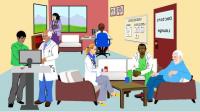You are only seeing posts authors requested be public.
Register and Login to participate in discussions with colleagues.
Medical Journal News
[Perspectives] Shirin Heidari: towards gender equity in health research
Shirin Heidari, the Executive Director of GENDRO and Senior Researcher at the Gender Centre, Geneva Graduate Institute in Switzerland, was born in Tehran 6 years before the 1979 Iranian revolution. Coming from a family with “many strong women as role models, and always a sense of activism”, the revolution, which “resulted in a regime oppressing women, men, as well as any dissidents, followed by political oppression and war”, left her with “a very strong distaste for injustice”, and a profound awareness, “very early on”, of the devastating impacts of “a lack of rights, and the lack of a justice system”.
Categories: Medical Journal News
[Perspectives] Pulling back the curtain: how physicians actually feel
As a clinician, educator, and emotion researcher, I have long believed that our efforts to optimise the wellbeing of health-care professionals are doomed if we cannot talk openly about the emotional and psychological experience of practising medicine. Hidden behind the more observable forms of distress we can measure, such as burnout, are unpleasant, complex, and entirely human experiences, such as feeling insecure or unlikeable, needing validation, experiencing shame or self-doubt, and wanting to feel loved and accepted.
Categories: Medical Journal News
[Perspectives] Deconstructing drugs
The Sainsbury Centre is an art museum situated on the University of East Anglia campus near Norwich, UK. Its Living Area—a calm, expansive exhibition space in a hanger-like, purpose-built, Norman Foster designed building—hosts a diverse permanent art collection, including works by modern artists such as Francis Bacon and Henry Moore, alongside historical objects from across the globe. This impressive core collection was donated by British businessman, philanthropist, and supermarket heir Sir Robert Sainsbury and his wife Lady Lisa Sainsbury.
Categories: Medical Journal News
[Obituary] Tim Radford
Science editor, journalist, author, and mentor. Born on Oct 9, 1940, in Rawene, New Zealand, he died in Eastbourne, UK, on Feb 10, 2025, aged 84 years.
Categories: Medical Journal News
[Correspondence] A call for health R&D prioritisation and governance mechanisms in Africa
Africa accounts for only 3% of all medicine production globally, and more than 90% of drugs and 99% of vaccines consumed are imported.1 The continent has not been well positioned to address these gaps due to capacity challenges related to limited research and development (R&D) infrastructure and skilled researchers, the absence of a well defined continental health research governance framework, and scarcity of sustainable financing for R&D.2 Moreover, there is inadequate local funding, and most research conducted on the continent is donor-driven and often not informed by national or regional priorities, underscoring the urgent need for research prioritisation, coordination, and governance.
Categories: Medical Journal News
[Correspondence] Canada and the EU united for global health, but challenges remain
Canada has joined the world's largest research and innovation programme (Horizon Europe), with its strong life science and technology focus and the launch of a policy dialogue to advance health priorities. Canada and the EU have taken steps towards transnational collaboration, which is paramount to successfully take on global challenges, such as cancer, antimicrobial resistance, health security, rare diseases, and non-communicable diseases.1,2 However, the proposed dialogue does not directly reference the crucial importance of health data access and exchange.
Categories: Medical Journal News
[Correspondence] Human rights in Argentina
In an Offline piece,1 Richard Horton commented on several issues regarding human rights and remembrance in Argentina.
Categories: Medical Journal News
[Correspondence] Going beyond the global blood donation index
We enjoyed the Viewpoint by Jeremy W Jacobs and colleagues and agree with their major observations.1 Defining the true need for blood is an essential challenge. The authors rightly noted that the annual blood donation to population ratio threshold cannot define true blood need. This definition should be specific to geographical scale and depend on disease burden, geographical heterogeneity and the isolation of communities in resource and disease distributions, and access to blood and blood products within the context of health-care access, among other factors.
Categories: Medical Journal News
[Correspondence] Home-based IVF monitoring
In their open-label, multicentre, randomised, non-inferiority trial of home-based ovulation monitoring in the management of frozen-thawed embryo transfers (FETs), Tjitske Zaat and colleagues showed their ability to organise national collaborative research efforts involving multiple fertility centres.1 In the accompanying Comment,2 Shari Mackens and Christophe Blockeel state that there is little in Zaat and colleagues’ study that warrants the consideration of home-based ovulation monitoring as a new gold standard.
Categories: Medical Journal News
[Correspondence] Natural or artificial menstrual cycle for frozen embryo transfer
In Tjitske Zaat and colleagues’ study,1 fewer than 3% of patients in natural menstrual cycles were administered exogenous progesterone for luteal phase support. In their Comment,2 Shari Mackens and Christophe Blockeel suggest that, with more evidence, progesterone supplementation could become part of the prescribed natural cycle frozen-thawed embryo transfer (FET) protocol. This change could simplify monitoring and reduce the number of hospital visits.
Categories: Medical Journal News
[Correspondence] TRiP(cast) score and thrombosis risk for lower limb immobilisation
In the CASTING study,1 the TRiP(cast) score was utilised to identify patients at low risk of venous thromboembolism. The cumulative incidence of venous thromboembolism was estimated to be 2·0%, indicating that most patients, approximately 98%, were at low risk and did not require anticoagulation. Therefore, it was inappropriate to identify low-risk subgroups from a population already consisting mostly of individuals at low risk of developing the condition. In contrast, there was no significant difference in the incidence of venous thromboembolism (1·1% vs 1·0%) between the intervention phase, guided by the TRiP(cast), and the control phase, during which 16% of patients would be classified as high risk but did not receive anticoagulation.
Categories: Medical Journal News
[Correspondence] TRiP(cast) score and thrombosis risk for lower limb immobilisation
We would like to congratulate Douillet and colleagues1 on their CASTING study, which showed a relevant reduction in prophylactic anticoagulation by using the TRIP(cast) score without an increase in the risk of venous thromboembolism. However, we were surprised by the inclusion of male sex as a risk factor in the TRIP(cast) score. The TRIP(cast) score was developed on the basis of two prior scores. One score was based on expert consensus (TIP score) that did not include male sex as a risk factor.
Categories: Medical Journal News
[Correspondence] TRiP(cast) score and thrombosis risk for lower limb immobilisation
I read with great interest the CASTING study by Douillet and colleagues.1 I appreciate the authors’ contribution; however, there are several issues I would like to discuss.
Categories: Medical Journal News
[Correspondence] TRiP(cast) score and thrombosis risk for lower limb immobilisation – Authors' reply
We thank Liang V Tang and colleagues, Perrine Truong and Francois-Xavier Ageron, and Wei Xiong for their interest in our CASTING study and their comments.
Categories: Medical Journal News
[Department of Error] Department of Error
Veltkamp R, Korompoki E, Harvey KH, et al. Direct oral anticoagulants versus no anticoagulation for the prevention of stroke in survivors of intracerebral haemorrhage with atrial fibrillation (PRESTIGE-AF): a multicentre, open-label, randomised, phase 3 trial. Lancet 2025; 405: 927–36—In this Article, the final sentence of the Findings in the Summary was incorrect and has been deleted. This correction has been made to the online version as of March 13, 2025, and the printed version is correct.
Categories: Medical Journal News
[Seminar] Human African trypanosomiasis
Human African trypanosomiasis or sleeping sickness is caused by infection with Trypanosoma brucei gambiense or Trypanosoma brucei rhodesiense parasites, which are transmitted by tsetse flies in sub-Saharan Africa. Control of human African trypanosomiasis is based on case detection, treatment, and vector control. In the past decade, simple rapid diagnostic tests were introduced for gambiense human African trypanosomiasis, facilitating screening in primary health-care facilities. A new oral drug, fexinidazole, became the first-line treatment for gambiense human African trypanosomiasis without severe meningo-encephalitic disease, as well as for rhodesiense human African trypanosomiasis.
Categories: Medical Journal News
[Articles] Behavioural interventions to increase uptake of FIT colorectal screening in Scotland (TEMPO): a nationwide, eight-arm, factorial, randomised controlled trial
Adding a single sentence suggesting a deadline for FIT return in the invitation letter to FIT colorectal screening resulted in more timely FIT return and reduced the need to issue reminder letters. This is a highly cost-effective intervention that could be easily implemented in routine practice. A planning tool had no positive effect on FIT return.
Categories: Medical Journal News
[Department of Error] Department of Error
Hirst JE, Witt A, Mullins E, Womersley K, Muchiri D, Norton R. Delivering the promise of improved health for women and girls in England. Lancet 2024; 404: 11–14—In this Comment, the second sentence and reference 1 to a Manual source have been removed because this reference was found not to be reliable. These changes have been made to the online version as of March 12, 2025.
Categories: Medical Journal News
[Comment] A turning point for global health: challenge or opportunity?
Investments in programmes such as the US President's Emergency Plan for AIDS Relief (PEPFAR), the Global Fund to Fight AIDS, Tuberculosis and Malaria, and the President's Malaria Initiative have saved millions of lives, strengthened health systems, and shown the power of sustained international cooperation.1,2 These programmes have not only advanced humanitarian goals but have also bolstered US economic and national security interests, reinforcing geopolitical stability in key regions, while expanding markets for American industries.
Categories: Medical Journal News
[Comment] Cost-effective improvement of real-world cancer screening
Colorectal cancer is the second leading cause of cancer-related death globally, accounting for more than 900 000 deaths each year.1 A large share of this burden could be avoided by well-organised screening programmes. In recent years, an increasing number of countries have introduced organised screening programmes with faecal immunochemical tests (FITs) directly sent, along with easy to understand information and instructions for use, to the eligible target population. Such programmes can achieve high adherence rates, well above 60%,2 and their introduction has been shown to be followed (after an initial apparent transient rise in incidence due to early detection of prevalent colorectal cancer) by a major reduction of both colorectal cancer incidence (in particular incidence of late-stage cancer) and mortality.
Categories: Medical Journal News




